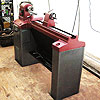In a thread I recently posted on a vase form, Prashun Patel inquired about "the tuck" and asked to what was the reference. It seems most folks use that term to refer to creating a slight "tightening of the curve" at the base to create the illusion of lift.
Since most all of the upright/vase forms one sees have a lower curvature that approximates a catenary or parabolic curve, and since there is a difference of preference on how to handle the base of the form, I thought it might be interesting and informative to explore the idea of "the tuck."
This image shows a catenary curve and a parabolic curve, as well as horizontal lines I have drawn in to represent possible points along those curves at which one might "truncate" the form, thereby creating the base. Obviously, the diameter of the piece affects these curves - a wider or more narrow form would produce a curve that would be somewhat different in appearance than these. But, for the purposes of this thread perhaps this image will work.
If one truncates the piece close to the tip, the curvature accelerates into a naturally formed "tuck". If it is truncated higher, there is naturally an absence of tuck. The smaller the base, the more natural "tuck" one achieves.
THE TUCK.jpg
So, to start the discussion, perhaps the following questions migh evoke some response.
Is "tucking" a design consideration for you? Do you like the look? Do you purposefully "tuck" your forms? Do you consider the mathematical or natural curvature in making that decision as to whether to tuck, or at what location? Does the anticipated diameter of the base effect your decision? Are there other considerations not stated above?
Since I have posed the questions, it is only fair I start the discussion. As I have stated previously, I do not care for an ultra small base on a vase form as I do not like the "tipsy" nature of such pieces. I do not care for a "tuck" that is imposed higher on the curve than it would naturally occur.
What say you??





 Reply With Quote
Reply With Quote
 Laugh at least once daily, even if at yourself!
Laugh at least once daily, even if at yourself!











 ... or even a bevel, than to see the kind of rolled under bottom that seems to be the trend right now (as Steven Carter at #3 defined it). In my opinion, the rolled under bottom doesn't make it "float", it makes an otherwise decent curve look bad. If you're going to tuck the bottom under, then the curve should be continuous, and not a change in direction...
... or even a bevel, than to see the kind of rolled under bottom that seems to be the trend right now (as Steven Carter at #3 defined it). In my opinion, the rolled under bottom doesn't make it "float", it makes an otherwise decent curve look bad. If you're going to tuck the bottom under, then the curve should be continuous, and not a change in direction...
